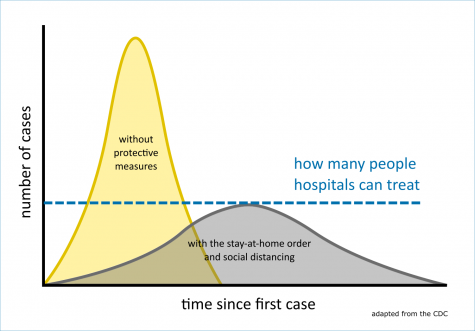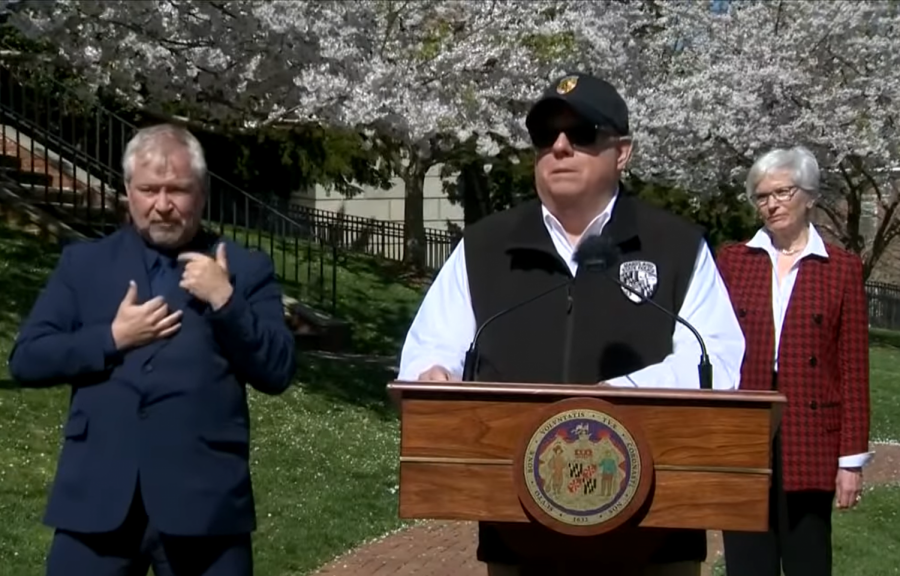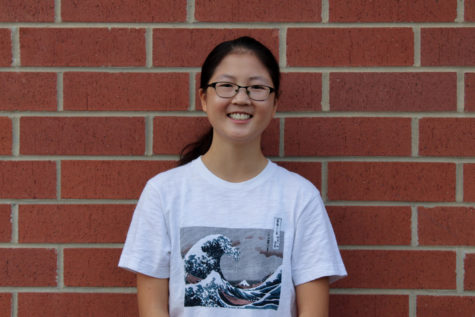Maryland residents to follow Governor Hogan’s ‘stay-at-home’ order
Photo courtesy of Governor Hogan’s press conference
Governor Hogan gives a new directive on social distancing at his latest press conference.
April 2, 2020
This Monday, Governor Larry Hogan issued a stay-at-home order requiring Marylanders to only leave their homes for “essential reasons,” such as buying food or medicine, seeking medical care or traveling to a job also deemed essential, in an effort to reduce the spread of the coronavirus.
“This is a deadly public health crisis. We are no longer asking or suggesting that Marylanders stay home. We are directing them to do so,” Hogan said during a news conference Monday morning.
Under the directive, Maryland residents will still be able to travel to schools to pick up meals and instructional materials for distance learning. Also permitted is exercising outside, such as running, hiking and biking, as long as these activities are performed at least six feet away from others and in groups of fewer than 10 people to comply with social distancing guidelines.
“People are not locked in their homes. We’re just telling people that they need to stay in their homes except for essential and necessary things,” Hogan said. “You should be able to get outside for your own mental well-being, go for a walk, walk your dog.”
Despite the stay-at-home order, the rate of infection in Maryland is still rapidly rising. Just on Thursday, Maryland confirmed another 346 new cases of the coronavirus, marking the largest single-day rise in new cases thus far. As of Thursday morning, there are 2,331 total cases in Maryland, with 498 in Montgomery County.
In addition, even a successful stay-at-home order will not completely halt the spread of the coronavirus. Because individuals will still need to leave their homes for essential reasons, there are still chances for asymptomatic carriers of the virus to spread it to others if they travel outside.
Nevertheless, it will take time for the stay-at-home order to show any positive effects. It can take up to two weeks for symptoms of COVID-19 to develop, and then another few days are needed for a patient to be tested and for their results to come back, so there will naturally be a lag between the enactment of such an order and a decrease in new cases.
The stay-at-home order adds to a series of executive orders made by Governor Hogan that have been strengthening social distancing restrictions. However, why is social distancing so essential to the coronavirus response?
Many have heard the term “flatten the curve” floating around for a couple of weeks now. The idea here is that by spreading out the infection over a period of months instead of weeks, there will be less stress on the health care system in their response to the pandemic. Rather than a sudden flood of coronavirus cases overwhelming hospitals, new cases will instead come in as a steady trickle, giving hospitals and manufacturers more time to ramp up capacity and production of medical equipment so that those who do contract the virus receive the best possible care.

Practicing social distancing guidelines and abiding by the stay-at-home order will help “flatten the curve” and reduce the strain on the health care system.
Yet, there is currently a nationwide shortage of testing kits for the coronavirus, basic supplies like swabs to use during testing, ventilators to keep patients with severe cases of the virus breathing, and face masks and other personal protective equipment (PPE).
Because of these shortages, many medical workers have been forced to reuse face masks in order to treat patients, although these masks are designed to be single-use. This increases their risk of infection, as it is possible that they could contract the virus from touching the surface of a contaminated mask, according to the CDC.
With more doctors and nurses lacking adequate protection against the coronavirus, compounded with their exposure to patients who may have the virus and having to work longer hours under immense stress, which could weaken their immune systems, a shortage of health care workers themselves is also a looming threat.
In the worst-case scenario, a lack of ventilators, hospital beds, and other vital equipment would require doctors to choose who receives potentially life-saving care and who will have to be turned away. According to the Baltimore Sun, a group of Maryland state leaders, ethicists and doctors are currently working on a plan about who to prioritize in the event of a critical shortage of ventilators. This plan emphasizes treating those who are likely to recover from the disease and are also healthy enough to survive in the longer term.
“These are conversations that no one wants to have. But we need to have these conversations just in case,” Dr. David Marcozzi, who is directing the coronavirus response for the University of Maryland Medical System, said in an interview with NBC News.
Governor Hogan has already taken steps to avoid such a scenario from becoming a reality. On Saturday, FEMA delivered 250 hospital beds to a field hospital set up in the Baltimore Convention Center, and Governor Hogan has also called for 6,000 additional hospital beds and for closed hospitals to reopen in preparation for a possible surge in COVID-19 cases.
This morning, @FEMA delivered 250 beds to the field hospital site at the Baltimore Convention Center. I’d like to thank @FEMA, the @MDNG, @MDDGS, @MDHealthDept, @UMMS, @HopkinsMedicine, and all of our partners working around the clock to coordinate these lifesaving resources. pic.twitter.com/N66TljHHxo
— Governor Larry Hogan (@GovLarryHogan) March 28, 2020
Even with the Maryland government taking action to combat the coronavirus pandemic, it is still crucial for individuals to adhere to the stay-at-home order to lessen the burden on hospitals and health care workers and protect those most vulnerable to the virus.
“[W]e have to stop the spread,” Fran Phillips, deputy secretary of the Maryland Department of Health said during a news conference Monday morning. “We have to do everything we can to stop this infection today so that next week and in the weeks to come there will be enough care available for those who do get sick.”



